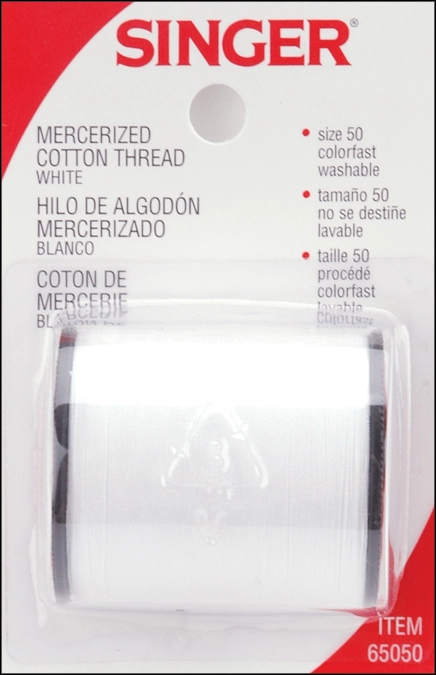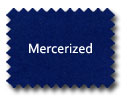 Mercerization is a process applied to cellulosic fibers – typically cotton (or cotton-covered thread with a polyester core) but hemp and linen can be mercerized also – to increase luster. It is done after weaving (in the case of fabrics) or spinning (for yarns or threads). But early on it was found that the process also had secondary benefits: the mercerized fibers were able to absorb more water, and therefore absorb more dye, making the color of the dyed cloth brighter and deeper. The difference is dramatic: mercerization increases the absorption of dyestuffs by as much as 25%.[1]
Mercerization is a process applied to cellulosic fibers – typically cotton (or cotton-covered thread with a polyester core) but hemp and linen can be mercerized also – to increase luster. It is done after weaving (in the case of fabrics) or spinning (for yarns or threads). But early on it was found that the process also had secondary benefits: the mercerized fibers were able to absorb more water, and therefore absorb more dye, making the color of the dyed cloth brighter and deeper. The difference is dramatic: mercerization increases the absorption of dyestuffs by as much as 25%.[1] 
 Not only is the color brighter, it also gives the cloth a better resistance to multiple washings, keeping the colors bright and unchanged over time. In addition to increasing luster and affinity to dyestuffs, the treatment increases strength, smoothness, resistance to mildew, and also reduces lint. So higher quality yarns and fabrics, for example, are always mercerized.
Not only is the color brighter, it also gives the cloth a better resistance to multiple washings, keeping the colors bright and unchanged over time. In addition to increasing luster and affinity to dyestuffs, the treatment increases strength, smoothness, resistance to mildew, and also reduces lint. So higher quality yarns and fabrics, for example, are always mercerized.
The process goes back to the 1880’s. John Mercer was granted a British Patent for his discovery that cotton and other fibers changed character when subjected to caustic soda (NaOh, also known as sodium hydroxide or lye), sulfuric acid, and/or other chemicals. One of the changes was that caustic soda caused the fiber to swell, become round and straighten out. But so what – these changes didn’t impart any luster to the fibers, so his patent was largely ignored. Then in 1890 Horace Lowe found that by applying Mercer’s caustic soda process to cotton yarn or fabric under tension, the fabric gained a high luster as a result of the light reflection off the smooth, round surface created by the NaOH. It became an overnight success and revolutionized the cotton industry. The rest is history.[2]
Later testing proved that cotton fiber in its roving state (no twist in the yarns) would absorb more NaOH than fiber in a twisted state and as a result would absorb more water or dye. Since fine, long stapled fiber gives the best absorption with the lowest twist, ( some twist is required for treating under tension to gain luster) it is usually the long fiber types of cotton (Sea Island, Egyptian, Pima) that are selected for yarn to be mercerized. So mercerized cotton fabric starts with a better quality cotton fiber.
How is it done?
To get the desired luster and tensile strength, cotton is held under specified tension for about ten minutes with an application of between 21%-23% caustic soda (NaOH) and wetting agents (used to facilitate the transfer of the NaOH into the fibers), at room temperature. Then the fabric is neutralized in an acid bath.
Luster is a result of light reflection off a surface. The more glass like the surface, the better the luster. Yarn in its spun, treated state still has a very fine covering of tiny fiber ends (fuzz). This fuzz is removed by passing the yarn (or fabric) through a controlled heated atmosphere termed singeing (gas fired in the past, electric more currently) resulting in a cleaner surface. (Luster is a result of light reflection off a surface. The more glass like the surface, the better the luster.)
You knew I’d have to look at the toxicity profile of sodium hydroxide, which is considered one of the building blocks of chemistry. It’s a very powerful alkali. It’s used in industry in a broad range of categories: chemical manufacturing; pulp and paper manufacturing; cleaning products such as drains, pipe lines and oven cleaners ; petroleum and natural gas; cellulose film; and water treatment as well as textiles. The US Food and Drug Administration (FDA) considers sodium hydroxide to be generally safe, and recognizes it as not being found to pose unacceptable dietary risks, though it is generally only used on food contact surfaces rather than in foodstuffs.
The chemical is toxic to wildlife, and the EPA requires that effluent containing NaOH not be discharged into groundwater. Because sodium hydroxide falls in the group of chemicals (salts) which are by far the most often used in textile processing, the sheer volume of NaOH used by the textile industry is important to recognize. Usual salt concentrations in cotton mill wastewater can be 2,000 – 3,000 ppm[3], far in excess of Federal guidelines for in-stream salt concentrations of 230 ppm. So treatment of effluent is very important, as prevention is the only reasonable alternative to solve the environmental problems associated with this hard-to-treat, high volume waste. I have read that electrochemical cell treatment might be a substitute for using NaOH to mercerize. This process occurs in a low voltage electrochemical cell that mercerizes, sours, and optionally bleaches without effluents and without the purchase of bulk caustic, neutralizing acids, or bleaches.
[1] Beaudet, Tom, “What is Mercerized Cotton?”, http://fiberarts.org/design/articles/mercerized.html
[2] Ibid.

What would be used as “wetting agents” (since they don’t say water) and “acid baths”?
“To get the desired luster and tensile strength, cotton is held under specified tension for about ten minutes with an application of between 21%-23% caustic soda (NaOH) and wetting agents (used to facilitate the transfer of the NaOH into the fibers), at room temperature. Then the fabric is neutralized in an acid bath.”
Hi Linda: The wetting agents are generally of two types: cryslic acid derivatives, such as ortho, meta and para cresols (with selected solvents such as triethyl or tributyl phosphate) and non-cryslic types, such as sulphated lower fatty alcohols such as hexyl or octyl alcohol. The acid bath is most commonly sulphuric acid but acetic acid or tartaric acid can be used, as well as simply using plain water.
Thank you! No wonder I have such a hard time finding clothing that is safe for me to wear. The chemicals get embedded at every stage of the process!
Check out http://www.11thLoop.com for sustainable textiles coming out of Arizona
I have been browsing online more than three hours today, yet I never found any interesting article
like yours. It is pretty worth enough for me. In my opinion, if all website owners
and bloggers made good content as you did, the internet will
be much more useful than ever before. Name is
VINCENT From Burbank
Pretty nice post. I simply stumbled upon your weblog and wished to
say that I’ve truly enjoyed browsing your weblog posts. After all I’ll be subscribing
in your rss feed and I’m hoping you write once more soon! Name is TALON I am from McKinney
I have a fabric that I want to use for reupholstery. It no longer comes mercerized. Will your company do the mercerization process on my fabric?
No, I’m sorry – we don’t have that capability.
Hello, is mercerised cotton same as teracotton?
We’ve never heard of teracotton, and a Google search didn’t help!
Tera cotta is the correct spelling. It’s a thread.